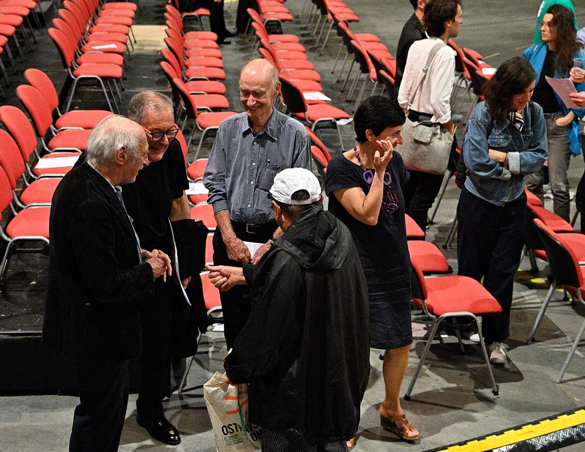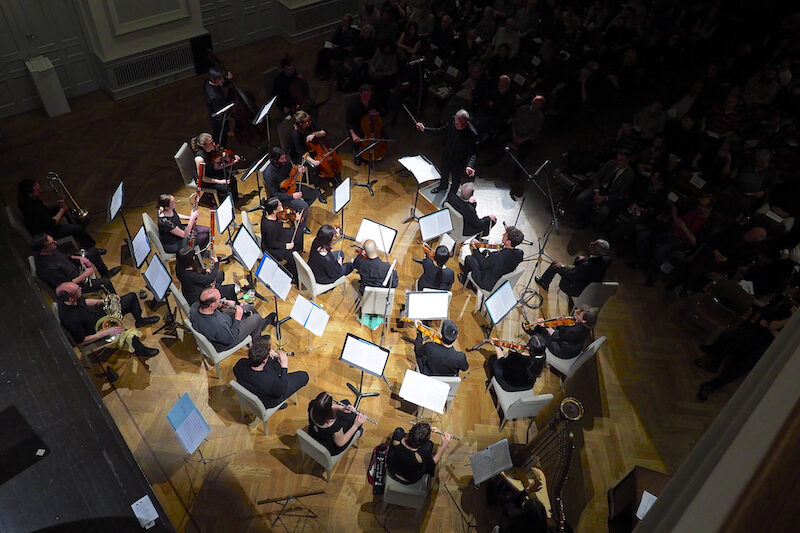Upcoming Concert:
S.E.M. Ensemble Presents
2024: THE YEAR OF CZECH MUSIC IN REVERSE
The Orchestra of the S.E.M. Ensemble
Petr Kotik, Conductor
April 24, 2024 @ 7pm
Bohemian National Hall
321 East 73rd Street, New York
RSVP here
Can't make it on April 24th?
Come to a preview on April 21st, 8pm
@
Willow Place Auditorium(26 Willow Place, Brooklyn 11201)
The year 2024 was declared The Year of Czech Music. Our understanding of nationality in the Arts is slightly different than the one commonly presented. What is nationality in relation to the composition of music? Do we really listen to music with nationality attached to it? Mozart’s Don Giovanni would never have been composed without the commission and support he received in Prague in 1787. Don Giovanni belongs as much to the Czech culture as well as to the Austrian. To top it off, it is sung in Italian.
Instead of identifying a nationality of music based solely on the composer's birth certificate, we propose a look at this issue based on the possibilities to create and realize the music. The program includes compositions by non-Czech nationals for whom the opportunities in the Czech Republic had a major impact, and in reverse, Czech composers by birth, for whom opportunities abroad had an equally pivotal impact.
Rudolf Komorous Tango (1986)
Anna Heflin The man who owned the forrest
also owned the racetrack (2023)
Petr Bakla String trio no. 2 (2017)
Petr Kotik Ariane – Sonata (2001/2024)
Christian Wolff Small Orchestra Piece (2019)
Phill Niblock Disseminate (2001)

L-R. Frederic Rzewski, Petr Kotik, Christian Wolff, Alivn Curran, Renata Spisarova,
James Falzone, Judith Berkson, Lucie Vítková at Ostrava Days 2019
About the composers:
Rudolf Komorous (b.1931)
The composer and bassoon player Rudolf Komorous studied in Prague at the Conservatory and Academy of Music. In 1957, he won the first prize at the International Competition in Geneva (Switzerland), which led to a 2-year teaching engagement at the Beijing Conservatory. Upon his return to Prague in 1961, he joined the new music ensemble, Musica viva pragensis which Petr Kotik started a few months before. Since 1969, he has lived in Canada. In 1971, he joined the faculty at the University of Victoria, British Columbia, where he became the head of the Composition Department. From 1989 until his retirement 1994 he served as director of School for the Contemporary Arts at Simon Fraser University, British Columbia. Well known Canadian composers, such as Christopher Butterfield, Owen Underhill, Linda Catlin Smith, Martin Arnold, Rodney Sharman, Allison Cameron and Rita Ueda, among others, studied with Komorous. They greatly appreciate his guidance and support. Komorous’ oeuvre includes many orchestral works (including 4 symphonies) as well as compositions for solo instruments, chamber ensembles, and voice, including operas No No Miya, and The Mute Canary (both performed, among other places, at the National Moravian-Silesian Theatre in Ostrava).
Anna Heflin (b. 1993)
"I had no idea what to expect when I arrived at Ostrava Days (OD) Institute as one of the residents in 2019 and was profoundly inspired by the culture, community, aesthetics, and history of the organization. I have since been to Ostrava three times and the support and confidence I have received from the OD organizers has had an immeasurable impact on my work. The international and intergenerational community that I’ve been participating in since has become part of my ethos and music-making. My compositional life as it stands now would be unthinkable without my working participation at Ostrava Days in the Czech Republic; it has continuously benefited my music making." – Anna Heflin, February 25, 2024
Petr Bakla (b. 1980)
"From my early days I was interested in and inspired by the music that came from America – music by composers such as Cage, Feldman, Wolff, Lucier and Niblock, their ideas and the ethos of their art. All this was distinctly different from the new music in Europe, which often - then and now – sounds academic and cliché-like. When, after the year 2000, I heard in Ostrava live performances of some of the most important compositions by these and other artists, it all seemed natural to me; there was no surprise in it, as if I would think at the time - there is really nothing else worth to perform. Ostrava also gave me an opportunity to personally know many of these great composers.
It cannot be overstated how important the opportunity to engage in this environment as a composer is for me – then and now. I have found opportunities that would have been unthinkable elsewhere, opportunities without which I would not have been able to write most of my compositions (including those I have written for other occasions). I cannot imagine what my music would look like today if it were not for the concerts initiated by the Ostrava Center for New Music both here in the Czech Republic, in Europe, and in the United States." – Petr Bakla, Prague, February 24, 2024
Petr Kotik (b. 1942)
Born in Prague, Czech Republic in 1942, Petr Kotik was educated as a flutist and composer both in Prague (Prague Conservatory and Academy of Music), and Vienna (Music Academy). While still a conservatory student, he started to perform concerts of new music, programs of leading and unknown composers including his own works. These concerts, independent of, and often controversial to the mainstream left an impact on the scene to such a degree that at the end of 1960s, Kotik was invited to come to the U.S. Shortly after his arrival in 1969, he founded the S.E.M. Ensemble to continue presenting concerts similar to those he had performed for almost a decade in Europe. As a composer, his music gradually changed after his arrival in America. Although Kotik’s compositions always stood outside of the conventional, the direction he took after 1970 would be unthinkable, would he stay in Europe. It indicates that artists and their outputs are not determined only by their vision, abilities and perseverance, but equally by opportunities they are given to by their surrounding environment.
Christian Wolff (born 1934)
"I first came to Ostrava, Czech Republic, in 2001 to be part of Ostrava Days Institute and Festival. I knew what I was coming to – Petr Kotik recruited me to give him advice as he planned the festival. I remember, for example, a few months earlier, meeting with Petr, Earle Brown and Alvin Lucier to discuss some details of the Ostrava Days program. I have been there every single time until 2015, and then again in 2019.
I am a United States composer, but the environment and support given to me in the Czech Republic has been substantial. It was my first extensive opportunity to compose for orchestra and immediately hear the music. Such an opportunity is completely absent in the U.S., except for Kotik’s performances here. In the period from 2001 to 2023, I made six orchestra compositions, all premiered in Ostrava and also performed in Prague. It is thanks to Kotik’s relentless efforts and the opportunities I was given, that my works for orchestra are a substantial part of my overall oeuvre. In addition, spending time at Ostrava Days gave me the opportunity to meet a number of Czech composers, hear their music, and exchange ideas. A very fruitful back and forth interaction." – Christian Wolff, February 28, 2024
Phill Niblock (1933-2024)
There are only a few artists, more linked to the New York Downtown scene than Phill Niblock. Arriving in 1958 from Anderson, Indiana, he immediately became part of the New York avant-garde Downtown scene, soon becoming a prominent photographer, filmmaker, composer and video artist. In all these disciplines, Niblock has been completely self-taught. The freedom from academia has been a striking aspect in Niblock’s art from the start, contributing to the originality and excellence of his works. For more than fifty years, Niblock also produced performances in the Experimental Intermedia loft (his own work-space in lower Manhattan), presenting a wide spectrum of independent musicians, filmmakers and performers (about fifty events each season).
Niblock’s music uses slowly changing, microtonally tuned layers of sound. Most of the time the sound is recorded, edited and performed with or without live musician(s). Niblock and Petr Kotik began their close collaboration in 1972, after meeting at Christian Wolff’s Burdocks festival in Vermont. When in 1992, the S.E.M. Ensemble expanded into an orchestra, Kotik commissioned Niblock to compose orchestra pieces, using live musicians instead of recorded material. At times, the size of the orchestras Kotik used for Niblock’s scores had up to a hundred musicians. Niblock has been part of every Ostrava Days Institute and Festival since its start in 2001, each time creating a new orchestra composition for the festival. His music would be quite different, without his 22 years of active participation in the Czech Republic’s Ostrava Days Festival.
About the Orchestra of the S.E.M. Ensemble
Founded in 1970 by Petr Kotik, the S.E.M. Ensemble is the oldest continuously performing American new music ensemble. In 1992, SEM expanded into The Orchestra of the S.E.M. Ensemble with a debut concert at Carnegie Hall. Throughout its existence, the S.E.M. Ensemble has been associated with composers such as John Cage, Pauline Oliveros, Julius Eastman, Morton Feldman, David Tudor, Christian Wolff, Roscoe Mitchell, Earle Brown, Maryanne Amacher, Alvin Lucier, La Monte Young, David Behrman, Alex Mincek and many others, including many young and emerging composers.
S.E.M. Ensemble champions music which is often called “experimental,” music that is rarely heard in mainstream productions. The openness in programming that Petr Kotik brings to SEM concerts follows his lifelong pursuit of artistic and intellectual matters that are authentic and relevant. Since the mid-1970s, SEM has performed annually at the Paula Cooper Gallery in New York, in addition to concerts at its venue in Brooklyn (the Willow Place Auditorium), and other locations throughout New York, from alternative spaces to major concert halls (Zankel Hall, Alice Tully Hall, etc.). SEM regularly tours in Europe and has also performed in South America and Japan.
"If there is still valor in the music world, it survives in men like Petr Kotik...Mr. Kotik [and the SEM] played [works] that would have made classical-music marketing departments blanche...." – The New York Times
With special thanks to The Consulate General of the Czech Republic in New York, and Consul General Arnošt Kareš. We would also like to thank the Czech Center in New York for their support.
S.E.M. Ensemble’s 2023-24 season has been made possible with the generous support of the New York State Council on the Arts in partnership with Governor Kathy Hochul and the New York State Legislature, with public funds from the New York City Department of Cultural Affairs in partnership with the City Council, The Amphion Foundation, The Alice M. Ditson Fund of Columbia University, The Aaron Copland Fund for Music, The Foundation for Contemporary Art, The Fritz Reiner Center for Contemporary Music, The Low Road Foundation, Sheldon Berlow, Stephen J. Deutsch, Virginia Dwan, Martina Forman, Philip Foster, Allegra Fuller Snyder, Beth Greenberg and Jim Wright, Charlotta Kotik, Raymond Learsy, Julian Lethbridge, Rotraut Moquay, and Noni Pratt. Special thanks to Paula Cooper, Jasper Johns, Werner Kramarsky, and Brooklyn District 33 Councilman Lincoln Restler.


